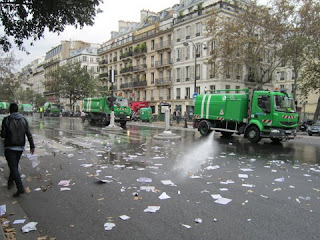“Lessons from Things” is the title of a chapter in Adam Gopnik’s charming and insightful memoir, Paris to the Moon. The phrase, he writes, “refers to a whole field of study, which you learn in class, or used to, that traces civilization’s progress from stuff to things...the passage of coffee from the bean to the porcelain coffeepot, or wine from the vine and soil to the bottle....”
I was thinking about this last Saturday, as we made our way up and down the crowded aisles of the Salon du Chocolat, held in one of the exhibition halls at Porte de Versailles. From cocoa bean to the most sumptuous truffle, from almond to the most delectable macaron, the most delicately flavoured calisson.
But the French don’t stop there. Given “stuff,” they set out to transform it, by dint of imagination, craft, patience and persistence, into fabulously elaborate “things.” A chocolate Arc de Triomphe embedded with 4000 Swarowski crystals. A chocolate Eiffel Tower with macaron cladding. A flower garden of calissons. Chocolate Oxfords.
These are the work of maîtres pâtissiers, the finest of whom, after demonstrating their skill under pressure in a competition held every four years, are privileged to wear the red, white and blue collar awarded to the Meilleurs Ouvriers de France. (Having seen The Kings of Pastry, the 2009 documentary film about the MOF competition, I had great respect for the Monsieur who was chopping up a chocolate accordion and handing out samples.)
















































